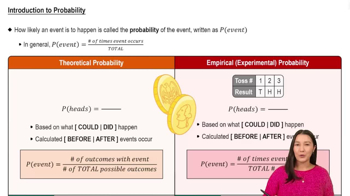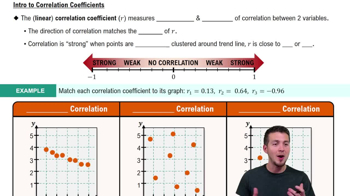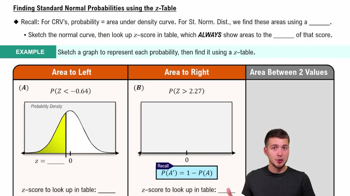If a single card is randomly selected from a deck of cards, what is the probability of selecting an ace or a king?
Table of contents
- 1. Intro to Stats and Collecting Data1h 14m
- 2. Describing Data with Tables and Graphs1h 55m
- 3. Describing Data Numerically2h 5m
- 4. Probability2h 16m
- 5. Binomial Distribution & Discrete Random Variables3h 6m
- 6. Normal Distribution and Continuous Random Variables2h 11m
- 7. Sampling Distributions & Confidence Intervals: Mean3h 23m
- Sampling Distribution of the Sample Mean and Central Limit Theorem19m
- Distribution of Sample Mean - Excel23m
- Introduction to Confidence Intervals15m
- Confidence Intervals for Population Mean1h 18m
- Determining the Minimum Sample Size Required12m
- Finding Probabilities and T Critical Values - Excel28m
- Confidence Intervals for Population Means - Excel25m
- 8. Sampling Distributions & Confidence Intervals: Proportion1h 12m
- 9. Hypothesis Testing for One Sample3h 29m
- 10. Hypothesis Testing for Two Samples4h 50m
- Two Proportions1h 13m
- Two Proportions Hypothesis Test - Excel28m
- Two Means - Unknown, Unequal Variance1h 3m
- Two Means - Unknown Variances Hypothesis Test - Excel12m
- Two Means - Unknown, Equal Variance15m
- Two Means - Unknown, Equal Variances Hypothesis Test - Excel9m
- Two Means - Known Variance12m
- Two Means - Sigma Known Hypothesis Test - Excel21m
- Two Means - Matched Pairs (Dependent Samples)42m
- Matched Pairs Hypothesis Test - Excel12m
- 11. Correlation1h 6m
- 12. Regression1h 50m
- 13. Chi-Square Tests & Goodness of Fit1h 57m
- 14. ANOVA1h 57m
4. Probability
Addition Rule
Problem 4.2.23
Textbook Question
In Exercises 21–24, use these results from the “1-Panel-THC” test for marijuana use, which is provided by the company Drug Test Success: Among 143 subjects with positive test results, there are 24 false positive (incorrect) results; among 157 negative results, there are 3 false negative (incorrect) results. (Hint: Construct a table similar to Table 4-1.)
Testing for Marijuana Use If one of the test subjects is randomly selected, find the probability that the subject tested positive or did not use marijuana.
 Verified step by step guidance
Verified step by step guidance1
Step 1: Organize the given data into a contingency table. Create a table with rows representing 'Test Result' (Positive or Negative) and columns representing 'Actual Use' (Used or Did Not Use). Use the provided data: 143 positive test results (24 of which are false positives) and 157 negative test results (3 of which are false negatives).
Step 2: Calculate the true positives and true negatives. True positives are the positive test results that are correct, which is 143 - 24. True negatives are the negative test results that are correct, which is 157 - 3.
Step 3: Fill in the contingency table. Use the calculated true positives, true negatives, false positives, and false negatives to complete the table. Ensure the totals for rows and columns match the given data.
Step 4: Use the contingency table to calculate the probability that the subject tested positive or did not use marijuana. This is the union of two events: (1) the subject tested positive and (2) the subject did not use marijuana. Use the formula for the union of two events: P(A ∪ B) = P(A) + P(B) - P(A ∩ B).
Step 5: Substitute the appropriate probabilities into the formula. P(A) is the probability of testing positive, P(B) is the probability of not using marijuana, and P(A ∩ B) is the probability of testing positive and not using marijuana (false positives). Divide the relevant counts by the total number of subjects to compute these probabilities.
 Verified video answer for a similar problem:
Verified video answer for a similar problem:This video solution was recommended by our tutors as helpful for the problem above
Video duration:
5mPlay a video:
Was this helpful?
Key Concepts
Here are the essential concepts you must grasp in order to answer the question correctly.
Probability
Probability is a measure of the likelihood that a particular event will occur, expressed as a number between 0 and 1. In this context, it involves calculating the chances of a subject testing positive for marijuana or not using it at all. Understanding how to compute probabilities from given data is essential for answering the question accurately.
Recommended video:

Introduction to Probability
False Positives and False Negatives
False positives occur when a test incorrectly indicates the presence of a condition, while false negatives occur when a test fails to detect a condition that is present. In this scenario, knowing the number of false positives and false negatives helps in determining the accuracy of the test results and affects the overall probability calculations.
Recommended video:
Guided course

Correlation Coefficient
Contingency Table
A contingency table is a data representation that displays the frequency distribution of variables, allowing for easy comparison of outcomes. Constructing a table based on the test results will help visualize the relationships between true positives, false positives, true negatives, and false negatives, which is crucial for calculating the required probabilities.
Recommended video:
Guided course

Finding Standard Normal Probabilities using z-Table

 5:14m
5:14mWatch next
Master Probability of Mutually Exclusive Events with a bite sized video explanation from Patrick
Start learningRelated Videos
Related Practice
Multiple Choice
